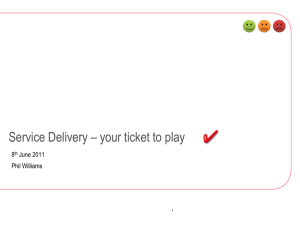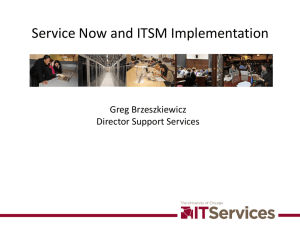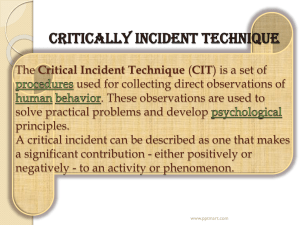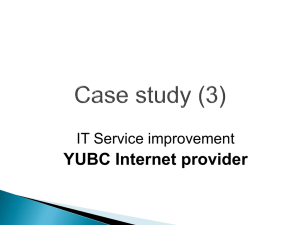2010 04 16 HDI Service Desk and Processes
advertisement
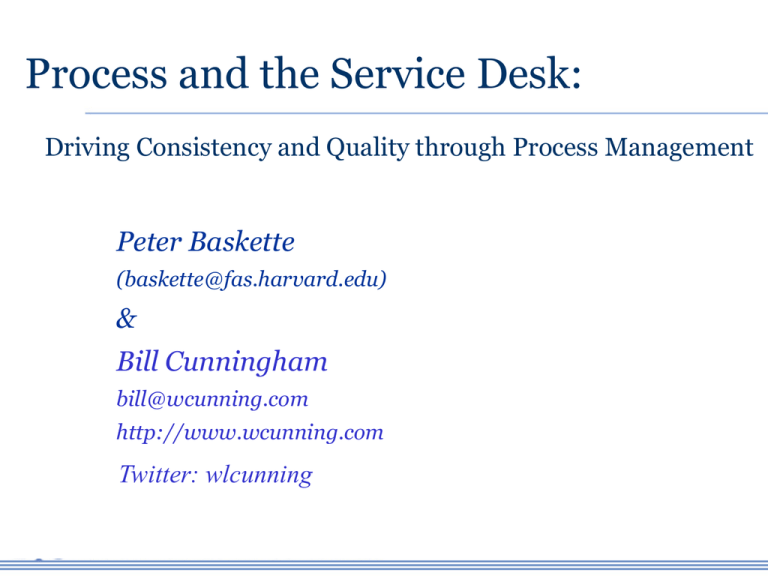
Process and the Service Desk: Driving Consistency and Quality through Process Management Peter Baskette (baskette@fas.harvard.edu) & Bill Cunningham bill@wcunning.com http://www.wcunning.com Twitter: wlcunning Agenda • Introduction – IT Service Management – Generic Process Model • ITIL Framework & Service Desk • The Service Desk – A Process Based Model • Questions 4 Process and the Service Desk: Driving Consistency and Quality through Process Management Process and the Service Desk: Driving Consistency and Quality through Process Management Process and the Service Desk: Driving Consistency and Quality through Process Management Help Desk Service Desk Help Desk Service Desk IT Service Management IT Service Management (ITSM) • Systems Management – Traditional IT management focus (well, not just IT) – Leads to ‘silos’ as IT organizes around technical specialties • Service Management – Clients and Customers do not consume the ‘systems’ IT Manages – They use IT Services 9 Definition of Service • “a service is a means of delivering value to customers by facilitating outcomes customers want to achieve without the ownership of specific costs and risks.” - ITIL v3 Service Strategy 10 Definition of Service Management • Service Management is a set of specialized organizational capabilities for providing value to customers in the form of services. • Service Management takes the form of a set of Functions and Processes for managing Services over their Lifecycle. • Service Management is also a professional practice supported by an extensive body of knowledge, experience and skills. -ITIL v3 Service Strategy 11 IT Services – IT Processes End –Users Clients People Infrastructure Information Applications IT Services IT Processes 12 ITSM, Frameworks and the Primary IT Value Chain Build Plan Demand/Relationship Mgt. Solutions Development ITIL Service Design ITIL Service Strategy -Service Portfolio T Theory of Conscious Alignment Run ITIL Service Transtion -Service Catalog -- SLM --Avail & Capacity -Transitions Planning/Suppt. --Change Management --- SACM (Configuration) -- Release and Deployment ---- Svc. Testing and Validation PMBOK Prince2 Agile SCRUM Critical Chain ISE Operations/Support SWEBOK ITIL v2 Service Support ITIL Service Operation -- Incident -- Problem CMM ITIL CSI BPM Theory of Constraints Derived from Charles T. Betz, Architecture and Patterns for IT Service Management, Resource Planning and Governance ITIL v3 Service LifeCycle 14 P-D-C-A “If you cannot define what you are doing as a process, you do not understand what you are doing.” -W. Edwards Deming Generic Process Model Roles & Resp. (ARCI) Resources The Process Inputs Process Owner Goals (Policies) Activities (Procedures) Key Terms KPIs & CSFs (Metrics) Outputs Reports Feedback 16 If You Can’t Measure - You Can’t Manage Principle of a Management Process: 1. You cannot manage what you cannot measure. 2. You cannot measure what you cannot define. 3. You cannot define what you do not understand. - W. Edwards Deming (1988) 18 ITIL V2 - Service Management Responsibility Pyramid Service Continuity Configuration Change Release Incident Service Desk Problem Availability Financial Service Delivery Capacity Service Level Service Support 19 Service Management Responsibility Pyramid: Problem and Incident (Support and Restore) Incident Service Desk Problem Service Support 20 ITSM, Frameworks and the Primary IT Value Chain Build Solutions Development ITIL Service Design ITIL Service Strategy -Service Portfolio T Theory of Conscious Alignment Operations/Support ITIL Service Transition -Service Catalog -- SLM --Avail & Capacity -Transitions Planning/Suppt. --Change Management --- SACM (Configuration) -- Release and Deployment ---- Svc. Testing and Validation PMBOK Prince2 Agile SCRUM Critical Chain ISE SWEBOK Problem ITIL v2 Service Support ITIL Service Operation -- Incident -- Problem Service Desk Demand/Relationship Mgt. Run Incident Plan CMM ITIL CSI BPM Theory of Constraints Derived from Charles T. Betz, Architecture and Patterns for IT Service Management, Resource Planning and Governance A Service Desk Management Model Knowledge Calls Email Voice mail Chat Walk-ins Incident Interaction End –Users Self-Service Problem Service Desk Service Requests Request Fulfillment RFIs 22 The Desk Itself Service Desk 23 Service Desk Definition • The Single Point of Contact between the Service Provider and the Users. • Manages Incidents and Service Requests. • Handles communication with users. • The Service Desk performs the first line support for IT Services. 24 Service Desk Tasks • Act as a single point of contact for users • “Own” inquiry from start (recording, status reports) to finish (close-out, monitoring satisfaction) • Monitor adherence to the service level agreements and take appropriate measures if there is a danger of failure to meet an agreement • Coordinate second level support and third-party support units • Provide management information to improve the service quality 25 Calls Email Voice mail Chat Walk-ins Interaction End –Users Interaction Management Service Desk Self-Service 26 Interaction Management - Benefits • Dedicated Service Desk Process • Pre-assignment of tickets – Standardizes greeting – Establishes initial questions, assessment, scripts. • Jumping off point to multiple Processes: – Incident, Service Request, Request for Information, Change, Others • Drives consistency for Incident and Request – Filters ‘Request for information’ type calls 27 Interaction Management - Goals • Effective routing and processing of inbound and outbound communications • Provision of interaction information to all persons working with a contact to ensure service consistency. 28 29 Interaction – Initiating Process Flow - Created with MetaStorm ProVision 30 Request For Information • Request for information – What’s someone’s phone number – Account storage quota • Do you track them? – Generally yes. • Separately? – Better to do so. • Why? – Compromises metrics for other Processes. 31 An ACD Digression GetHuman.com • Website for by-passing phone trees. • Four Suggestions: – Always be able to ‘0’ out to get a human. – System should estimate wait times every 60 seconds. – Be concise: Avoid verbose prompts – When no one is available, option to leave a message 32 The Support and Restore Processes (troubleshooting) Calls Email Voice mail Chat Walk-ins Knowledge RFI s Interaction End –Users Self-Service Problem Incident Service Desk 33 Incident Management • An Incident: – Unplanned interruption to an IT Service or a reduction in the quality of Service. – In essence, Break/Fixes or Service Degradation – Examples: • Computer won’t boot today • Network is slow • Incident Management Goal: – Restore normal service as quickly as possible 34 35 Incident Mgt. Controls & Measures (sample) Control Incidents classified according to SLAs- SD to monitor all Incidents until closure SD procedures include escalation criteria and communication procedures if SLAs in danger of breech and/or workarounds not available SD procedures for timely monitoring and clearance of customer queries include resolution/closure and confirmation steps to ensure action taken has been agreed by customer Produce reports for the measurement of service performance including response times and trends. IM able to leverage past incidents and knowledge base to improve speed and quality of response Measure •% Incidents closed within SLA •% Incidents requiring escalation •% Incidents without workarounds •Distribution of Incidents by severity •% unresolved Incidents required to be forwarded to Problem Management •% calls a bandoned •Distribution of call answer times •% calls cleared/closed during initial contact •% customers satisfied (relative to SLA) •Average MTTR relative to service targets •% Incident records successfully matched to IM, PM, and/or KB records. 36 Incident Mgt. – High Level Model Created with MetaStorm ProVision 37 Incident Classification and Initial Support Created with MetaStorm ProVision 38 Service Management Responsibility Pyramid: Problem and Incident (Support and Restore) KB Incident Service Desk Problem Service Support 39 ITIL v2 Support and Restore Triad 40 41 Problem Management Process Flow 42 A Case for Knowledge Management 600 500 Ticket Count 1st Quarter By Category 400 300 200 100 0 1 6 11 16 21 26 31 36 41 46 51 56 61 66 71 76 81 86 91 96 101 106 111 116 121 126 131 136 141 146 151 156 44 Service Requests • A Service Requests is: – Request to do something for a user – A request from a User for information, or advice, or for a Standard Change or for Access to an IT Service. – Examples: • Install an application on my computer • Upgrade memory • Password reset • NOT a break/fix -- often less urgent 45 Request Fulfillment • Request Fulfillment: – Process responsible for setting up access to the organization’s computer systems. Examples: • userids and passwords • authentication and authorization • Can be embedded in Service Requests • But helps if separate, dedicated process: – Streamlines procedures for account creation and levels of access or authority. – Establishes distinct on-boarding process 46 47 A Service Desk Model - Redux Knowledge Calls Email Voice mail Chat Walk-ins Incident RFIs Interaction End –Users Self-Service Problem Service Desk Service Requests Request Fulfillment RFCs (Change Mgt) 48 Interaction – Initiating Process Flow 49 50 Change Mgt – High Level Process 51 What’s the Process point? Why create distinct Processes? • One Answer: Management Metrics • Leads to informed decisions: – Organizational Structure – Investment Decisions – Procedures & Work Flow • Or, more fundamentally… 52 Deming’s Process Mandate 85% of a worker's effectiveness is determined by the system he works within, only 15% by his own skill. -W. Edwards Deming Reflective Questions • Do you distinguish between incidents and requests? Handle them differently? • Do you collect metrics? Do they drive your decisions? Your Vision? • Do RFIs compromise your data? • Do you have consistent Interaction Management? Scripts? Standard greetings? 54 Another question How to get there? • If you choose to pursue formal Processes: • Implement as a project • Organizational Change – Recognize this is Cultural Change – Use an Organizational Change Model 55 Questions bill@wcunning.com http://www.wcunning.com 56 57 A Service Desk Model – Support and Restore Knowledge Calls Email Voice mail Chat Walk-ins Incident Interaction End –Users Self-Service Problem Service Desk 58 Implementing Process: Managing Change Eight Stages of Leading Change, John Kotter 1. Create Sense of Urgency 2. Create Guiding Coalition 3. Develop a Change Vision & Strategy 4. Communicate the Change Vision 59 Still Managing Change Kotter’s 8-Stage Process continued: 5. Empower Broad-based Action 6. Generate Short-term Wins 7. Consolidate Gains and Product more Wins 8. Anchor New Approaches in the Culture 60 Thrasher’s Value Chain Cut Potatoes Fry Slices Fries in Containers Take Orders • Hand Container • Take Money 63 OK, So What’s the Point?
